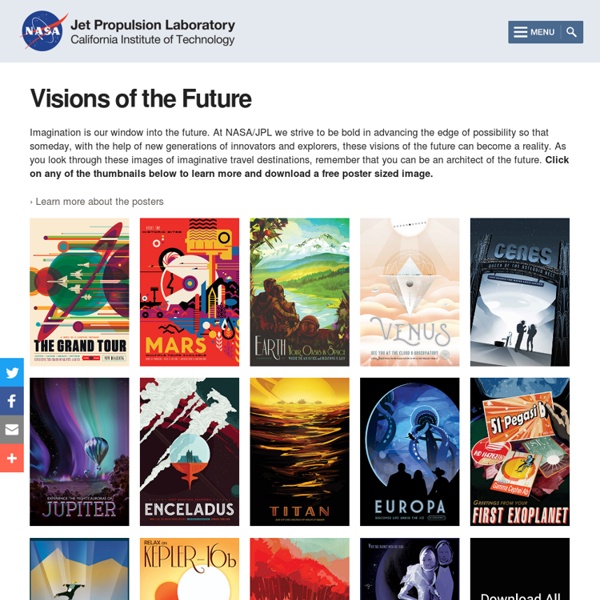



http://www.jpl.nasa.gov/visions-of-the-future/
Related: Universe & Multiverse • annieliz • scienceThe Cosmic Accident of Life: Alan Lightman on Dark Energy, the Multiverse, and Why We Exist Questions like why our world exists and what nothing is have occupied minds great and ordinary since the dawn of humanity, and yet for all our scientific progress, they continue to do so, yielding only hypotheses rather than concrete answers. But there is something immutably heartening in the difference between the primitive hypotheses of myth, folklore and religion, which handed off such mysteries to various deities and the occasional white-bearded man, and the increasingly educated guesses of modern science. In the title essay of his excellent The Accidental Universe: The World You Thought You Knew (public library), which also gave us this beautiful meditation on science and spirituality, Alan Lightman points to fine-tuning — the notion that the basic forces propelling our universe appear to be fine-tuned in such a way as to make the existence of life possible — as a centerpiece of how modern scientists have attempted to answer these age-old questions.
Facts about Children’s Literacy According to the National Center for Education Statistics (NCES), a divison of the U.S. Department of Education1, children who are read to at home enjoy a substantial advantage over children who are not: Twenty-six percent of children who were read to three or four times in the last week by a family member recognized all letters of the alphabet. This is compared to 14 percent of children who were read to less frequently.
Remarkable New Theory Says There's No Gravity, No Dark Matter, and Einstein Was Wrong Gravity is something all of us are familiar with from our first childhood experiences. You drop something - it falls. And the way physicists have described gravity has also been pretty consistent - it’s considered one of the four main forces or “interactions” of nature and how it works has been described by Albert Einstein’s general theory of relativity all the way back in 1915. But Professor Erik Verlinde, an expert in string theory from the University of Amsterdam and the Delta Institute of Theoretical Physics, thinks that gravity is not a fundamental force of nature because it's not always there.
Gallery - HubbleSite Search all of HubbleSite Search Picture Album Picture Album: Entire Collection Results per page: Design Action for Science » Posters Anonymous The good thing about science is that it’s true whether or not you believe in it. Sarah Williamson Is our Milky Way galaxy a zombie, already dead and we don't know it? Kevin Schawinski, Swiss Federal Institute of Technology Zurich Like a zombie, the Milky Way galaxy may already be dead but it still keeps going. Our galactic neighbor Andromeda almost certainly expired a few billion years ago, but only recently started showing outward signs of its demise. I’ve Got Research. Yes, I Do. I’ve Got Research. How About You? In 1847, Hungarian doctor, Ignaz Semmelweis made a remarkable discovery. When doctors washed their hands in a solution of chlorine and water, childbirth fever rates at Vienna General Hospital dropped from 18% to near zero. Offended that Semmelweis implied doctors were killing their own patients, the medical community rejected hand washing as an infection prevention measure, and drove Semmelweis out of medicine and into an insane asylum.
After centuries, scientists have finally figured out how water conducts electricity It's a textbook moment centuries in the making: more than 200 years after scientists started investigating how water molecules conduct electricity, a team has finally witnessed it happening first-hand. It's no surprise that most naturally ocurring water conducts electricity incredibly well - that's a fact most of us have been taught since primary school. But despite how fundamental the process is, no one had been able to figure out how it actually happens on the atomic level. The Top 10 Reasons Students Cannot Cite or Rely On Wikipedia 10. You must never fully rely on any one source for important information. Everyone makes mistakes. This genius map explains how everything in physics is connected Physics is a huge, complex field. It also happens to be one of the most fascinating, dealing with everything from black holes and wormholes to quantum teleportation and gravitational waves. But unless you have an innate knowledge of the field, it's pretty hard to figure out how all these concepts actually fit together - and how they tie in with the stuff like the physics of inertia and circuits that we learnt in high school. After all, everyone is constantly trying to prove Einstein wrong, and Stephen Hawking has famously struggled to come up with a 'theory of everything', so it's easy to get confused about how things do actually fit together in physics (if at all). If just the thought of a physics map breaks you out in an anxious sweat, but we promise it's a lot less scary when you see it: